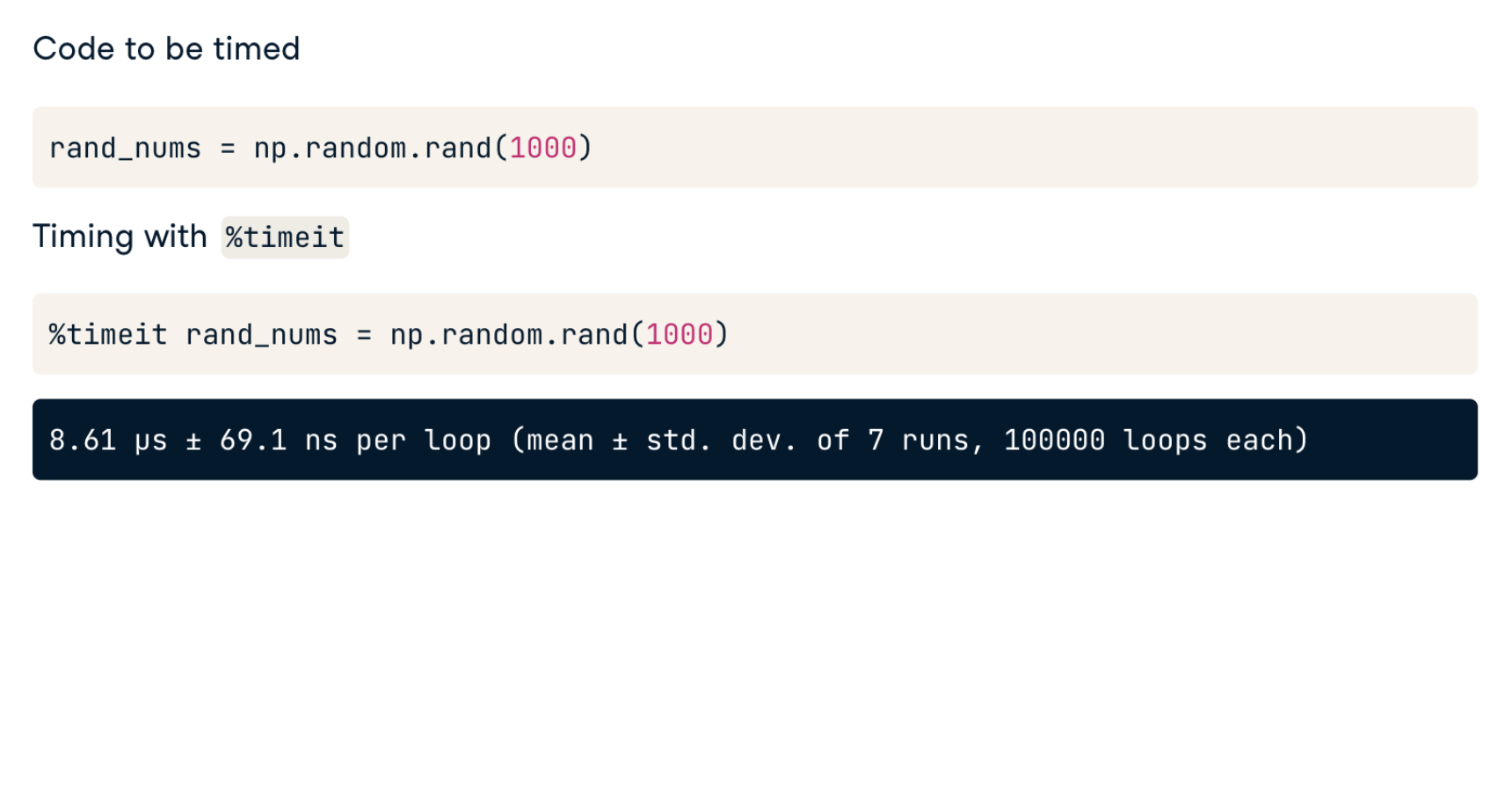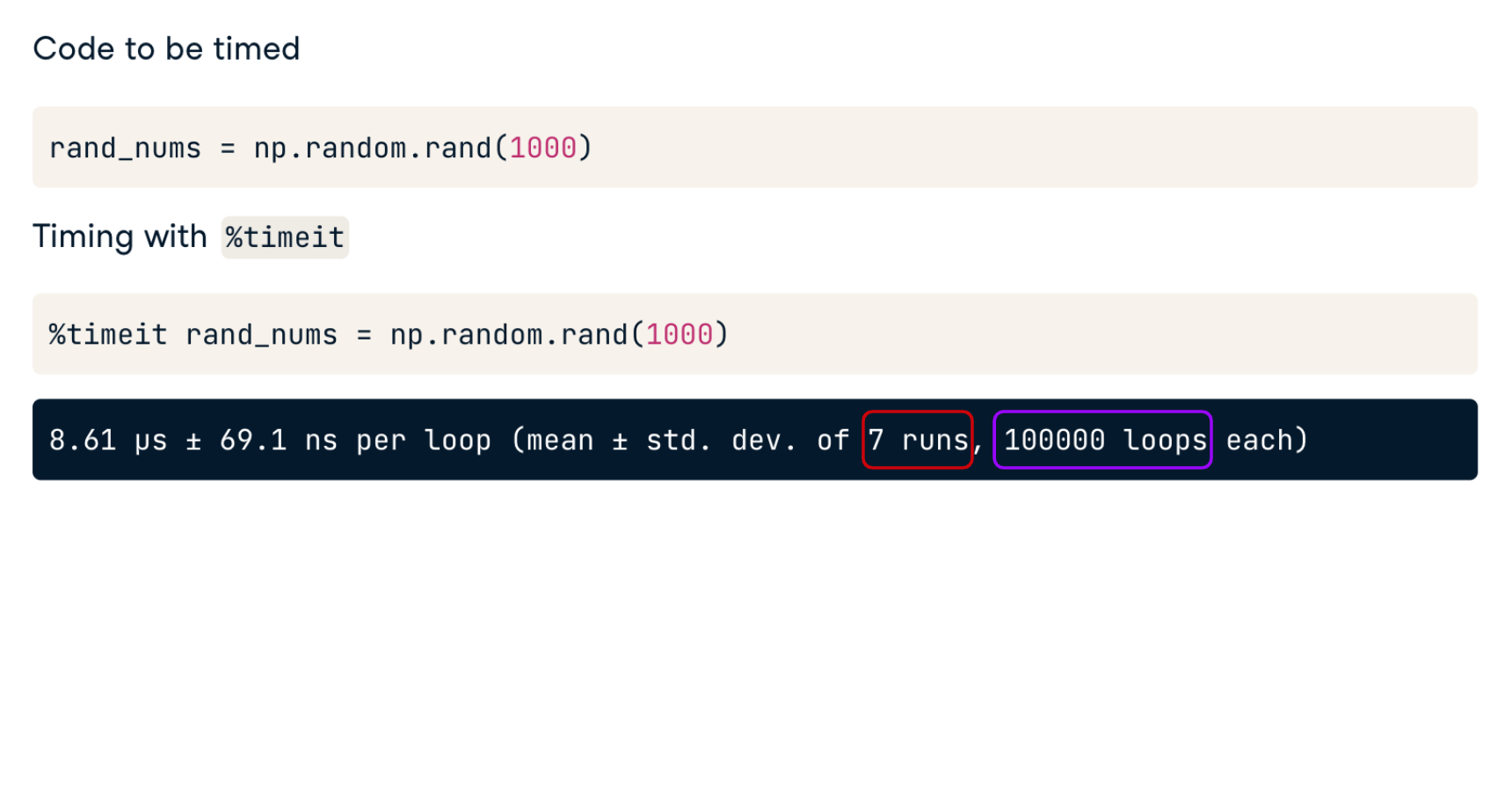Examining runtime
Writing Efficient Python Code

Logan Thomas
Scientific Software Technical Trainer, Enthought
Why should we time our code?
- Allows us to pick the optimal coding approach
- Faster code == more efficient code!
How can we time our code?
Calculate runtime with IPython magic command
%timeitMagic commands: enhancements on top of normal Python syntax
- Prefixed by the "%" character
- Link to docs (here)
- See all available magic commands with
%lsmagic
Using %timeit
Code to be timed
import numpy as np
rand_nums = np.random.rand(1000)
Timing with %timeit
%timeit rand_nums = np.random.rand(1000)
8.61 µs ± 69.1 ns per loop (mean ± std. dev. of 7 runs, 100000 loops each)
%timeit output

%timeit output

%timeit output

Specifying number of runs/loops
Setting the number of runs (-r) and/or loops (-n)
# Set number of runs to 2 (-r2)
# Set number of loops to 10 (-n10)
%timeit -r2 -n10 rand_nums = np.random.rand(1000)
16.9 µs ± 5.14 µs per loop (mean ± std. dev. of 2 runs, 10 loops each)
Using %timeit in line magic mode
Line magic (%timeit)
# Single line of code
%timeit nums = [x for x in range(10)]
914 ns ± 7.33 ns per loop (mean ± std. dev. of 7 runs, 1000000 loops each)
Using %timeit in cell magic mode
Cell magic (%%timeit)
# Multiple lines of code
%%timeit
nums = []
for x in range(10):
nums.append(x)
1.17 µs ± 3.26 ns per loop (mean ± std. dev. of 7 runs, 1000000 loops each)
Saving output
Saving the output to a variable (-o)
times = %timeit -o rand_nums = np.random.rand(1000)
8.69 µs ± 91.4 ns per loop (mean ± std. dev. of 7 runs, 100000 loops each)
times.timings
[8.697893059998023e-06,
8.651204760008113e-06,
8.634270530001232e-06,
8.66847825998775e-06,
8.619398139999247e-06,
8.902550710008654e-06,
8.633500570012985e-06]
times.best
8.619398139999247e-06
times.worst
8.902550710008654e-06
Comparing times
Python data structures can be created using formal name
formal_list = list()
formal_dict = dict()
formal_tuple = tuple()
Python data structures can be created using literal syntax
literal_list = []
literal_dict = {}
literal_tuple = ()
f_time = %timeit -o formal_dict = dict()
145 ns ± 1.5 ns per loop (mean ± std. dev. of 7 runs, 10000000 loops each)
l_time = %timeit -o literal_dict = {}
93.3 ns ± 1.88 ns per loop (mean ± std. dev. of 7 runs, 10000000 loops each)
diff = (f_time.average - l_time.average) * (10**9)
print('l_time better than f_time by {} ns'.format(diff))
l_time better than f_time by 51.90819192857814 ns
Comparing times
%timeit formal_dict = dict()
145 ns ± 1.5 ns per loop (mean ± std. dev. of 7 runs, 10000000 loops each)
%timeit literal_dict = {}
93.3 ns ± 1.88 ns per loop (mean ± std. dev. of 7 runs, 10000000 loops each)
Off to the races!
Writing Efficient Python Code

